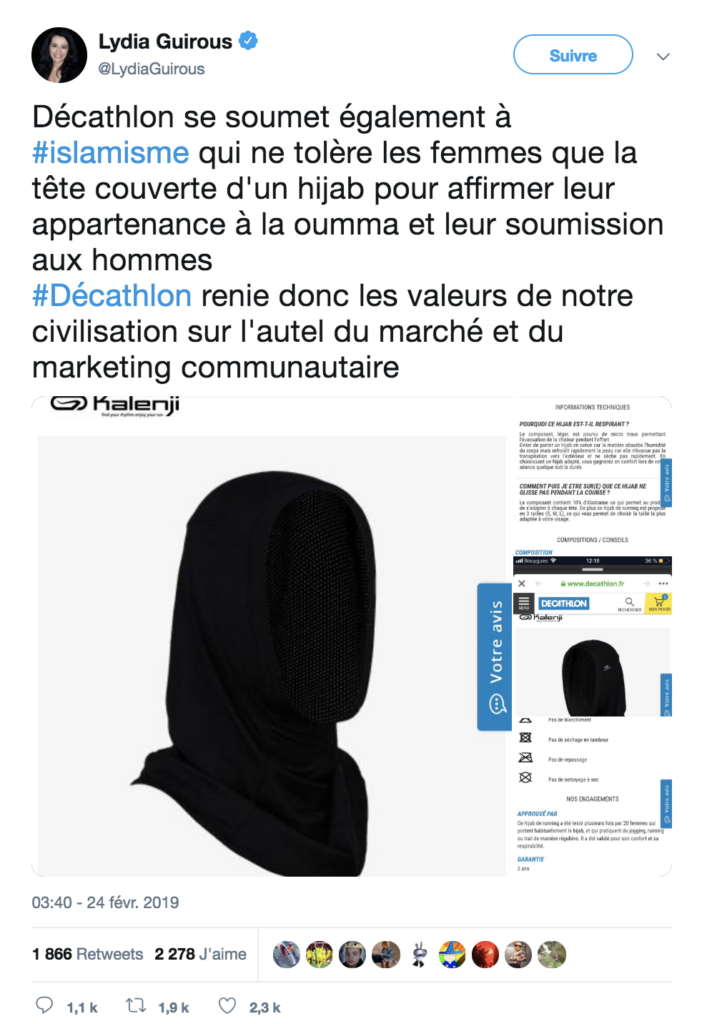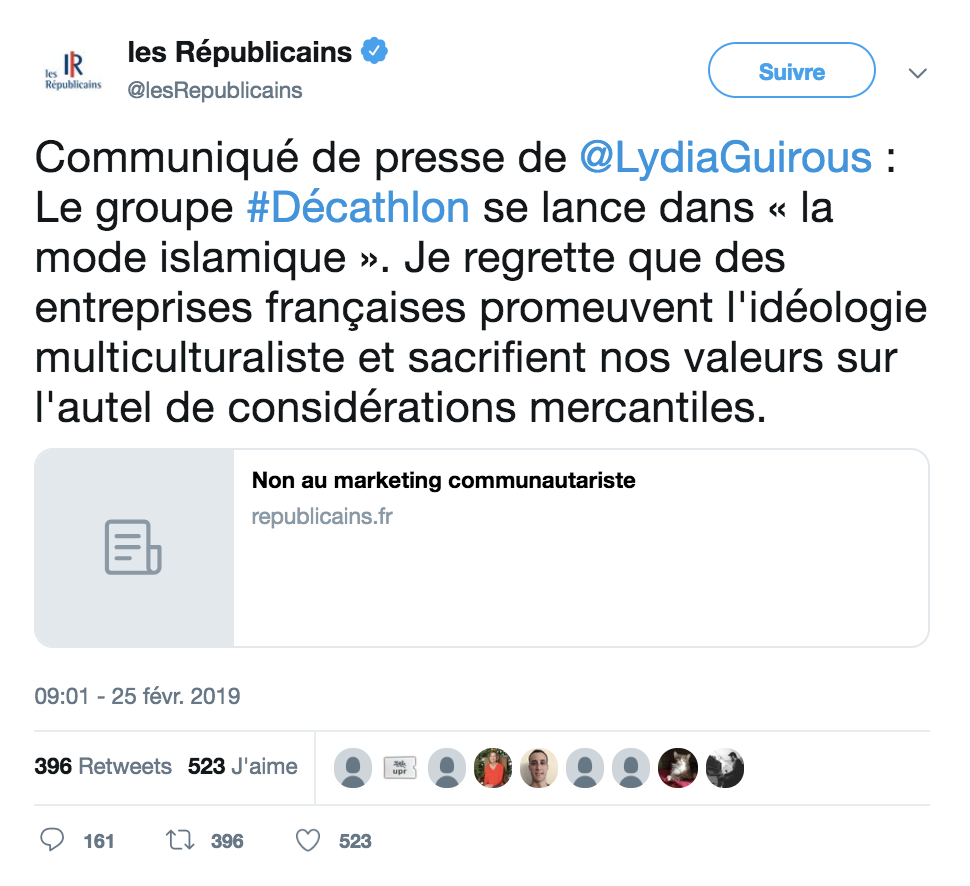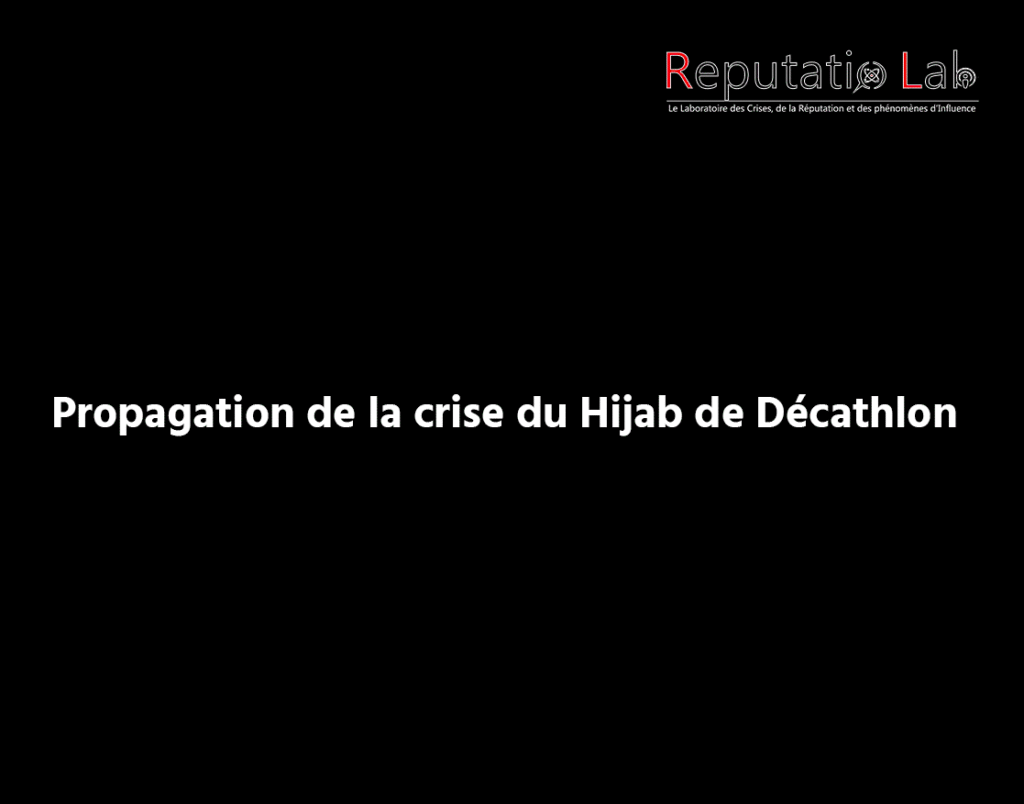Sommaire
The Décathlon Hijab Controversy: The Spectator as a Communication Tool on Social Media
It was the controversy of the week: the Décathlon Hijab and its political manipulation gained significant visibility, with no less than 500,000 tweets in just a few days. How did it spread? What was the crisis communication, and is Décathlon really in crisis? These are the questions I tried to answer!

A typical spread
A polarized crowd with the media as viewers and projectors into the real world
The story begins with an article published on Al-Kanz.

Lydia Guirous reacted to it.

At the same time, someone claiming to be from the feminist movement made a critique that was widely picked up.

While there were hardly any retweets on this matter (fewer than 4,000 tweets on the first day), La Dépêche made it into an article.
The next day, a statement from Les Républicains appeared.

Immediately afterward, Valérie Boyer chimed in.

In defense of the Hijab, a tweet by Madjid Messaoudene offered a counterbalance.

11:00 AM | A rant on Sud Radio was the topic.
An article from Le Figaro then appeared.
After that, the media machine picked up, with Le Point and BFM TV covering it.

he controversy had started.

Thus, we always have:
- A current event related to a societal issue and Islam.
- A right-wing appropriation to denounce it.
- Once the media picks it up, the machine gets going.
- People react to it. AJ+ takes the opportunity to denounce the climate, and RT pushes its narratives.
https://twitter.com/RTenfrancais/status/1100499829652942849
However, in this case, unlike the typical news story with a trivial incident, there was a brand and a community manager involved. This created an opportunity to involve more people in the debate.
If we consider the keywords (hijab or Islamic or boycott or veil or burkini or boycott or Arab or (great replacement) or Islam or racist or (women's role) or identity or secularism).


A known pattern in digital crises
What happened to Décathlon is quite typical in bad buzz cases. However, it took on a volume not previously seen.
In 2016, the Canadian government ran an ad featuring a woman wearing a hijab.

H&M used a hijab model for the first time, as did L'Oréal, which created controversy when the model's old social media posts resurfaced.

In 2018, GAP used a hijab for a young girl, which also sparked controversy.

In short, the situation was known and rather contained, as there were no collateral damages in these various cases.
Décathlon dragged into an arena that isn't Its own
This is an extremely complicated phase in current crises, but in this crisis, Décathlon isn't actually the main actor. Décathlon is dragged into an arena that isn't its own and is used by different communities to discuss a broader and more societal issue. It's very complicated because, whatever Décathlon's response, it won't satisfy everyone due to the absence of a unified demand, which is often the case in most crises.

Crisis communication that turns the spectator into a weapon
The most interesting aspect in terms of strategy is that by portraying itself as a victim, Décathlon activates a much larger audience than the one targeting it—the spectator.
This is one of the key lessons most addressed in crisis communication training: the most important audience is the spectator. According to experts, they represent 1% producers, 9% relayers, and 90% spectators—a vast majority, and they must be the focus of all crisis communication efforts.
By victimizing itself, halting the Hijab, and through Décathlon's community manager, the spectator with no opinion on the matter had an opportunity to voice their perspective, changing the narrative on social media and creating a movement with a different opinion.
The focus then shifted to the politicians and instigators. This is evident in the activity curve, where mentions of Décathlon without the Muslim context show a much larger increase.

Focus on the community manager
By signing all their tweets and responding to different internet users, the community manager distinguished themselves, even making their first name a trending topic.
This hadn't been observed since Bouygues Telecom and their community manager Tanguy, who responded one by one to comments attacking his company over the arrival of Free on the market.
This approach can be good because it humanizes the brand, but it can also be bad if it gives the impression that the community manager is alone in handling the crisis. There is thus no definitive good or bad, but in the case of Décathlon, it clearly leans towards the good, contributing to Décathlon's crisis communication strategy.
Moreover, if we closely examine the case from a societal perspective, we could say that the community manager was the spokesperson for an expression that doesn't materialize on social media, since neutrality doesn't exist. They were the spokesperson for those who don't care and think it's a debate that doesn't deserve this much attention.
Photo credit: Shutterstock / Décathlon Screenshot



